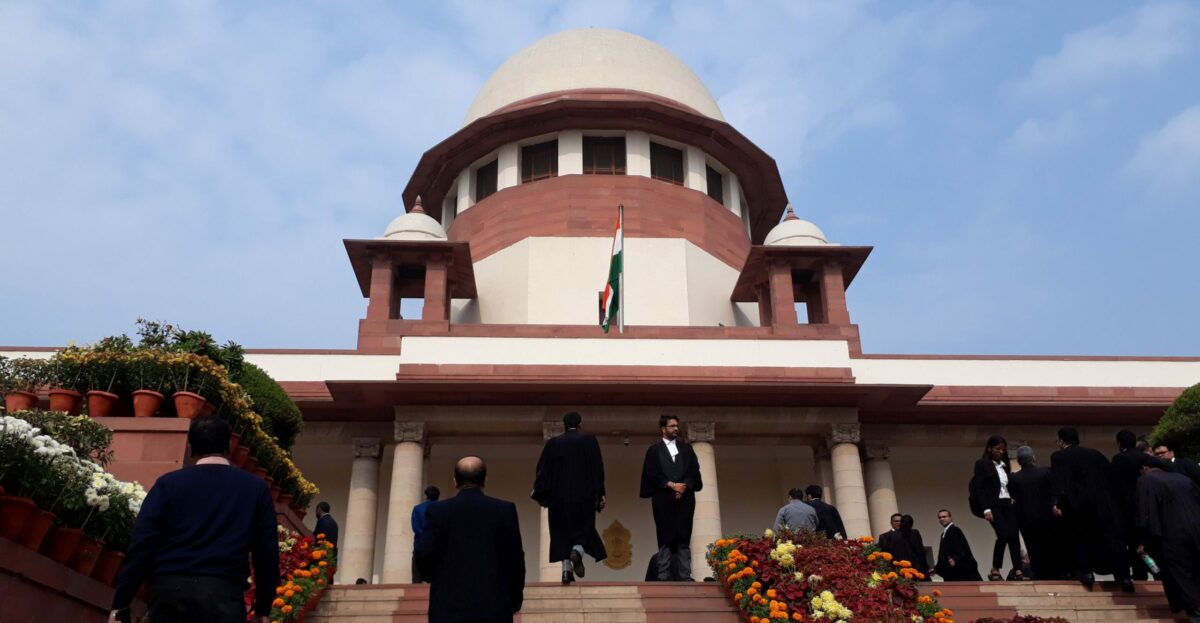Those challenging the abrogation of Article 370 argue that it is a permanent feature of the Constitution, while the Centre says it was a temporary arrangement.

The Supreme Court of India. (Wikimedia Commons)
A lot hangs on how the Supreme Court rules on Monday, 11 December, on a clutch of pleas challenging the abrogation of Article 370 in Jammu and Kashmir.
The verdict has implications on the status of the Union Territories (UTs) that the state of J&K was divided into, the fate of functional democracy in the border region, and how the world perceives the changed status of what was once one of the world’s geopolitical hotspots.
A concerned Union government has ensured there is enough security in J&K in light of the anticipated apex court’s verdict.
The regional parties of the former state, including the National Conference and the People’s Democratic Party, are as anxious as the residents about how their politics will change following the verdict.
On 5 August, 2019, the President issued the Constitution (Application to Jammu and Kashmir) Order of 2019, which diluted Article 370 — the law that provided special status to J&K in the form of autonomy over local administration and its Constitution.
The order replaced the term “Constituent Assembly” from Article 370(3) with “Legislative Assembly” (of J&K).
Simultaneously, the Centre introduced a statutory resolution in the Rajya Sabha to abrogate most of Article 370.
The concurrence of the J&K Assembly was not possible because the state was under President’s Rule.
The following day, 6 August, Parliament passed the J&K Reorganisation Bill of 2019, bifurcating the state into the Union Territories of Jammu & Kashmir and Ladakh.
Several petitions were filed in the Supreme Court challenging the Centre’s actions on the border state.
They raised the following questions:
Experts, like former Lok Sabha secretary-general PDT Achary, have contended that India was a Union of States under Article 1 of the Constitution, giving it a federated structure.
If Parliament could convert any state into a UT under Article 3 (though, as he says, this Article is silent on such conversion), it would become a precedent for converting any or all states into UTs.
However, that was not the intention of Article 3. Also, changing States to UTs would dilute the federal character of India and its status as a Union of States.
The second point he made was that Parliament could pass any law when a state was under the President’s Rule, but it could not “deputise” for the state where deciding on a Bill changing the area, boundaries or name of the state was concerned.
The Centre was well aware of this concern. That was why it told the Supreme Court and repeated it outside that the present status of J&K as a UT was “temporary”, and that the government would “restore” J&K’s statehood as soon as the Election Commission held elections.
However, the Centre never answered whether it went against the law and its spirit by converting the state of J&K into a UT.
Four years later, between 2 August and 5 September this year, a five-judge bench of the Supreme Court conducted 16 hearings in the case.
The bench led by Chief Justice DY Chandrachud comprised Justices Sanjay Kishan Kaul, Sanjiv Khanna, Bhushan R Gavai and Surya Kant.
At the end of the hearings, the court reserved the judgement on 5 September.
The petitioners were represented by some of the most prominent legal luminaries, including Kapil Sibal, Gopal Subramanium, Rajeev Dhavan, Dushyant Dave, and Gopal Sankaranarayanan.
Experts contend it was difficult to assess the impact of the Supreme Court verdict whichever way it would go.
Four years have passed since the abrogation, during which the officialdom in the UT of J&K has tightened its hold over all aspects of governance.
The judgement going either way would allow the political class to use it as a plank for the 2024 Lok Sabha elections.
Importantly, the judgment would go a long way in defining the nature of India’s federal structure and parliamentary processes, apart from allowing the international community to re-assess India on its internal democratic dealings.
The last implication was important in light of Union Home Minister Amit Shah telling Parliament a couple of days ago that Pakistan-occupied Kashmir was a part of India, because of which 24 seats had been kept reserved for the region in the Jammu and Kashmir Assembly.
The Ministry of External Affairs saw no need to clarify the home minister’s remarks, as “our position on PoK is very clear, we consider it a part of India, and we certainly see no reason to change our statement…”
The Union government already calls post-abrogation J&K the “Naya Kashmir”.

May 19, 2024

May 19, 2024

May 18, 2024

May 18, 2024

May 17, 2024

May 17, 2024